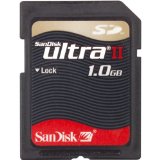
SD (secure digital) cards are becoming increasingly popular for digital camera storage. They’re tiny, convenient, and getting affordable in sizes as large as 1GB and 2GB. But they come in a bewildering array of different speeds and prices, even within one manufacturer’s line. What’s with the different card speeds, and which one do you need for your camera? This article gives you the details.
Understanding SD Card Speeds
While the first SD cards were very similar between brands, each brand now offers cards in several different speeds for each capacity. To make things more confusing, SD card speeds are measured in two different ways: in kilobytes or megabytes per second (KB/s or MB/s) and in an “x” rating similar to that of CD-ROMS. The “x” is the minimum CD-ROM speed of 150KB/s, so here’s a table of equivalent speeds:
- 4x: 600 KB/s
- 16x: 2.4 MB/s
- 40x: 6.0 MB/s
- 66x: 10MB/s
- 133x: 20MB/s
Understanding available options
While this varies between manufacturers, most offer two or three categories of speed. At this writing, here’s a summary of what each category means:
- Basic SD cards (Sandisk, Lexar, etc.) are the cheapest models. They generally have a speed of 1x to 16x, but often don’t guarantee a particular speed, so you won’t find anything about speed listed on the package.
- “Pro” SD cards (Sandisk Ultra, Lexar High Speed, etc.) list a speed of 32X or higher. Some have speeds up to 66x (10Mbps).
- High-end SD cards (Sandisk Extreme, Lexar Professional, etc.) have a speed of at least 66x. The latest models (i.e. Sandisk Extreme III) have a speed of 133x.
Since these categories are vague, and not always meaningful—for example, Sandisk’s “Ultra II” and “Extreme” cards are the same speed, but “Extreme III” is a higher speed—you should always compare based on the actual speed listed on the package. If it isn’t listed, assume you’re looking at one of the slowest cards.
Which one do you need?
Which speed you need depends on your camera. While even the fastest cameras can make do with a slow SD card, they’ll be at their best with a card that keeps up with the camera. Here are some general rules for choosing a card:
- If your camera is a consumer point-and-shoot model ($400 or less) chances are it works fine with any SD card. Some of the newest models can benefit from a 66x card for burst (multiple picture) or movie modes.
- If your camera is a “prosumer” model or a digial SLR ($400 to $3000) choose the fastest card you can get for a good price, a 66x card if at all possible. These cameras are fast, and a fast card will improve their response time.
Note that I haven’t recommended 133x cards for any camera. The SD card specification (version 1.0) is limited to 66x, so the 133x cards work in a “double speed” mode available in version 1.1 of the specification. At this writing, no cameras take advantage of the full speed of these cards, but you may want to consider one anyway—there’s a good chance you’ll still have the card when you upgrade to the next camera.
Conclusion
If you want the final word on which card to choose, check your camera’s manual or specification for speed requirements. Note that “burst” or movie modes may require higher speeds than still photo modes. Another tip: find a review of your camera at a site like DPReview.com, which does timing tests on cameras to determine their speed with different cards.
Another thing to consider is getting pictures from your camera to your computer. If you have a fast card and a fast card reader, you’ll enjoy the faster transfer speeds even if your camera doesn’t need them. Most USB 2.0 card readers (available for $10 to $20) can handle very high speeds. In fact, this is the one area where the 133x cards actually live up to their promise.
One more tip: definitely choose one of the good name-brand cards over the cheaper generics. With potentially 500 or more photos at stake, you don’t want to take chances. Sandisk, Lexar, Viking, Verbatim, and Crucial are good brands.

